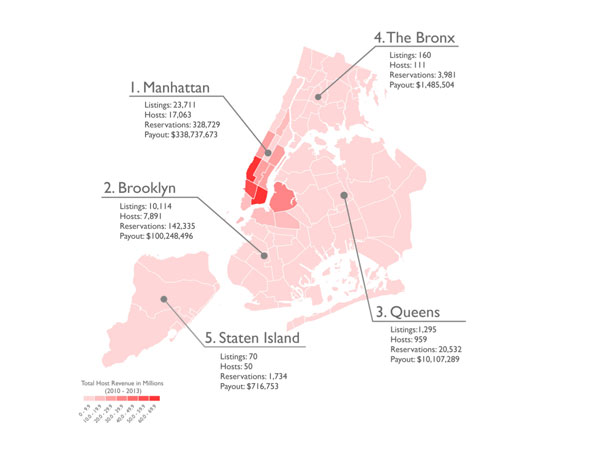BY YANNIC RACK | The “home-sharing” service Airbnb was under fire once again this week, after affordable housing advocates released a report that they say details the extent of the company’s staggering number of often-illegal rentals in New York City.
The study, published by New York Communities for Change and Real Affordability for All, found that more than 20 percent of the apartments in some of the city’s least affordable neighborhoods are offered for short- and long-term stays through the site.
The East Village topped the list, with a whopping 28 percent of its units available on Airbnb, according to the study. Also in the top 10 were the West Village, Lower East Side and Greenwich Village, with roughly 23, 20 and 18 percent of apartments, respectively.
By analyzing census data as well as listings on the site itself, the survey also found that nearly 60 percent of the offers were categorized as entire homes or apartments, which would make them illegal.
It also claimed that the site has taken over about 10 percent of the city’s available housing stock.
“This report confirms what we have known for a long time,” said City Councilmember Corey Johnson, whose district includes the Village.
“Illegal hotel rooms are eroding our affordable housing stock. By overloading the market with expensive short-term rentals, they are reducing the supply of housing and driving rents up.”
Last October, a report by state Attorney General Eric Schneiderman found that nearly three-quarters of rental units listed on Airbnb violated state or local laws.
The state Multiple Dwelling Law, which is cited most often in these cases, prohibits rentals of less than 30 days within dedicated residential buildings.
The exception is where someone rents out a room while still occupying the home or apartment at the same time, with all parts of the dwelling made available to the paying guest.
“This area is very thick with Airbnb, the 10012 zip code, which they’re identifying as Soho but which is also Little Italy,” said Georgette Fleischer, who has lived at 19 Cleveland Place, a 16-unit building off Petrosino Square, for 20 years.
“It’s a real problem. It’s kind of come to a breaking point here in New York,” she said, adding that the number of people living in her neighborhood who are not legal residents is increasing steadily.
The Villager last year reported on the illegal deregulation that residents said was going on at Fleischer’s rent-stabilized building, paving the way for illegal hotels.
According to Fleischer, two of the building’s tenants had been periodically — and professionally — renting out their units while living elsewhere, charging more than double the market rate for the apartments.
The visitors often left bags of trash in the hallways and in front of the building and even broke the front-door lock.
“It was harrowing,” she said, adding that she believes illegal short-term rentals are still going on in at least one of the building’s units.
“Airbnb is swallowing up entire apartments and charging tourists more than 300 percent of the average rent in areas of my Senate district, including the East Village, the Lower East Side and Greenwich Village,” state Senator Brad Hoylman said in response to the latest report.
“We need to put New York City families first and make sure they have access to affordable housing,” he said.
Hoylman, as well as Johnson and a host of other politicians, is part of the Share Better campaign to fight the spread of illegal hotels in the city.
Airbnb maintains that most of its users utilize the site to earn some extra cash while they’re out of town. But the study’s authors say that the average rental was available for 247 days a year, and actually rented 109 nights a year.
In an article in the Daily News, an Airbnb spokesperson dismissed the report as “lies, fuzzy math and faulty stats.”
“The notion that 1 in 4 apartments in the East Village is rented via Airbnb is not just ludicrous, it is also not supported by a single piece of data,” the spokesperson told the News.
On Thursday, an Airbnb spokesperson explained to The Villager why the company considered the study inaccurate.
The reason for the high number of days that apartments are listed for on average, he explained, was that the majority of hosts tend to leave their calendars open and then decide to rent on a case-by-case basis.
He also took issue with the claim that up to 28 percent of East Village rentals were on Airbnb, arguing that the definition of vacancy under the census was different from what many associate with the word, and that it also includes units that are not actually on the open market.
The Airbnb spokesperson emphasized that the company wants to “work with lawmakers to fix local law to allow people to share the home in which they live.”
Heather, a 37-year-old Arizona resident, is one of the many out-of-towners who have recently used the service to visit New York.
“I’m a fan of Airbnb because hotel rates are often prohibitive for a cost-mindful traveler,” she said.
During a five-day stay in June, Heather rented a private room in an East Village apartment, near Houston St. and Avenue C.
“It’s a great way [for the host] to earn extra income. If the only way you can afford anything in New York is to sublet, then I see no issue with that,” she said, adding that her host was living in the apartment during her entire visit.
She also said she wouldn’t stay in an apartment that was illegally offered through Airbnb.
“I’m not a proponent of anyone breaking the law,” she said.


















